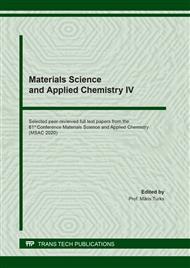[1]
J. Karger-Kocsis, L. Mészáros, and T. Bárány, Ground tyre rubber (GTR) in thermoplastics, thermosets, and rubbers,, J Mater Sci, vol. 48, no. 1, p.1–38, Jan. 2013,.
DOI: 10.1007/s10853-012-6564-2
Google Scholar
[2]
S. K. De, A. Isayev, and K. Khait, Eds., Rubber Recycling, 1 edition. Boca Raton, FL: CRC Press, (2004).
Google Scholar
[3]
A. Rowhani and T. J. Rainey, Scrap Tyre Management Pathways and Their Use as a Fuel—A Review,, Energies, vol. 9, no. 11, Art. no. 11, Nov. 2016,.
DOI: 10.3390/en9110888
Google Scholar
[4]
V. Lapkovskis, V. Mironovs, I. Jevmenov, A. Kasperovich, and V. Myadelets, Multilayer material for electromagnetic field shielding and EMI pollution prevention,, Agronomy Research, vol. 15, p.1067–1071, May (2017).
Google Scholar
[5]
M. Sambucci, D. Marini, and M. Valente, Tire Recycled Rubber for More Eco-Sustainable Advanced Cementitious Aggregate,, Recycling, vol. 5, no. 2, Art. no. 2, Jun. 2020,.
DOI: 10.3390/recycling5020011
Google Scholar
[6]
V. Lapkovskis, V. Mironovs, A. Kasperovich, V. Myadelets, and D. Goljandin, Crumb Rubber as a Secondary Raw Material from Waste Rubber: A Short Review of Processing Methods,, Sep. 2020,.
DOI: 10.20944/preprints202009.0315.v1
Google Scholar
[7]
M. Marín-Genescà, J. García-Amorós, R. Mujal-Rosas, L. M. Vidal, J. B. Arroyo, and X. C. Fajula, Ground Tire Rubber Recycling in Applications as Insulators in Polymeric Compounds, According to Spanish UNE Standards,, Recycling, vol. 5, no. 3, Art. no. 3, Sep. 2020,.
DOI: 10.3390/recycling5030016
Google Scholar
[8]
Y.-T. Lin, G.-L. Zhuang, M.-Y. Wey, and H.-H. Tseng, The Viable Fabrication of Gas Separation Membrane Used by Reclaimed Rubber from Waste Tires,, Polymers, vol. 12, no. 11, Art. no. 11, Nov. 2020,.
DOI: 10.3390/polym12112540
Google Scholar
[9]
Ł. Zedler, D. Kowalkowska-Zedler, X. Colom, J. Cañavate, M. R. Saeb, and K. Formela, Reactive Sintering of Ground Tire Rubber (GTR) Modified by a Trans-Polyoctenamer Rubber and Curing Additives,, Polymers, vol. 12, no. 12, Art. no. 12, Dec. 2020,.
DOI: 10.3390/polym12123018
Google Scholar
[10]
F. Cavalieri, F. Padella, and F. Cataldo, Mechanochemical surface activation of ground tire rubber by solid-state devulcanisation and grafting,, Journal of Applied Polymer Science, vol. 90, no. 6, p.1631–1638, 2003,.
DOI: 10.1002/app.12829
Google Scholar
[11]
S. H. Lee, A. M. Shanmugharaj, V. Sridhar, Z. X. Zhang, and J. K. Kim, Preparation and characterisation of polypropylene and waste tire powder modified by allylamine blends,, Polymers for Advanced Technologies, vol. 20, no. 7, p.620–625, 2009,.
DOI: 10.1002/pat.1307
Google Scholar
[12]
V. Myadelets, A. Kasperovich, and V. Farofontov, Application of siliceous compounds in recycling of vulcanised wastes based on nitrile rubber,, Proceedings of BSTU, vol. Chemistry, Organic Substances Technology and Biotechnology, no. 4, p.103–106, (2013).
Google Scholar
[13]
P. J. Flory, Statistical Mechanics of Swelling of Network Structures,, J. Chem. Phys., vol. 18, no. 1, p.108–111, Jan. 1950,.
Google Scholar
[14]
Handbook of Organic Solvent Properties. Elsevier, 1996.
Google Scholar
[15]
J. Brandrup, E. H. Immergut, and E. A. Grulke, Polymer Handbook, 4th ed., 2 vols. Wiley, (2003).
Google Scholar
[16]
L. E. Nielsen, Models for the Permeability of Filled Polymer Systems,, Journal of Macromolecular Science: Part A - Chemistry, vol. 1, no. 5, p.929–942, Aug. 1967,.
DOI: 10.1080/10601326708053745
Google Scholar
[17]
J. Lamminmäki, S. Li, and K. Hanhi, Feasible incorporation of devulcanised rubber waste in virgin natural rubber,, Journal of Materials Science, vol. 24, no. 41, p.8301–8307, 2006,.
DOI: 10.1007/s10853-006-1010-y
Google Scholar
[18]
M. Luo, X. Liao, S. Liao, and Y. Zhao, Mechanical and dynamic mechanical properties of natural rubber blended with waste rubber powder modified by both microwave and sol–gel method,, Journal of Applied Polymer Science, vol. 129, no. 4, p.2313–2320, 2013,.
DOI: 10.1002/app.38954
Google Scholar
[19]
M. M. Hassan, R. O. Aly, S. E. A. Aal, A. M. El-Masry, and E. S. Fathy, Styrene butadiene-based blends containing waste rubber powder: Physico-mechanical effects of mechanochemical devulcanisation and gamma irradiation,, Journal of Industrial and Engineering Chemistry, vol. 19, no. 5, p.1735–1742, Sep. 2013,.
DOI: 10.1016/j.jiec.2013.02.014
Google Scholar
[20]
J. Yun, A. I. Isayev, S. H. Kim, and M. Tapale, Comparative analysis of ultrasonically devulcanised unfilled SBR, NR, and EPDM rubbers,, Journal of Applied Polymer Science, vol. 88, no. 2, p.434–441, 2003,.
DOI: 10.1002/app.11741
Google Scholar
[21]
M. Ridhwan et al., The Effects of Different Particle Sizes of Recycled Acrylonitrile Butadiene Rubber and its Blend Ratios on Mechanical and Morphological Properties of vNBR/rNBR Blends,, MATERIALE PLASTICE, vol. 51, p.201–204, Jun. (2014).
DOI: 10.1080/03602550802355206
Google Scholar
[22]
K. Formela, M. Klein, X. Colom, and M. R. Saeb, Investigating the combined impact of plasticiser and shear force on the efficiency of low temperature reclaiming of ground tire rubber (GTR),, Polymer Degradation and Stability, vol. 125, p.1–11, Mar. 2016,.
DOI: 10.1016/j.polymdegradstab.2015.12.022
Google Scholar
[23]
M. S. Sobhy, M. M. M. Mahdy, M. A. K. El-Fayoumi, and E. M. Abdel-Bary, Effect of waste rubber powder in SBR formulations on the swelling of different organic solvents,, Polymer Testing, vol. 16, no. 4, p.349–362, Aug. 1997,.
DOI: 10.1016/s0142-9418(96)00056-6
Google Scholar
[24]
A. N. Gent, Engineering with Rubber: How to Design Rubber Components, 3rd ed. München: Carl Hanser Verlag GmbH & Co. KG, 2012.
Google Scholar


